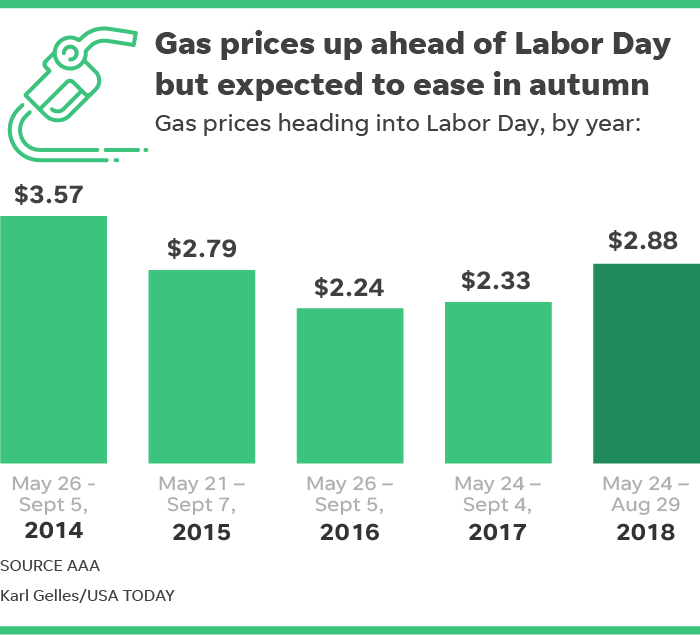
Pearl's odometer rolled over 42,000 miles yesterday, so it's time for another driving update. Before I do, I'm repeating what I did in May, examining the effect of the U.S. leaving Iran nuclear agreement pushes on oil prices. For that, I turn to Reuters, which reported yesterday Oil rises on Iran sanctions, lower U.S. fuel inventories.
Oil prices rose on Thursday, extending gains on growing evidence of disruptions to crude supply from Iran and Venezuela and after a fall in U.S. crude inventories.U.S. light crude, also known as West Texas Intermediate (WTI), has been around $70/barrel since May. The bad news is that is high; the good news is that it hasn't gone higher — yet. Just the same the result has been the highest gas prices in four years, as USA Today reported this morning in Gas prices: After most expensive summer since 2014, expect some relief at the pump.
Benchmark Brent crude oil LCOc1 was up 50 cents a barrel at $77.64 by 1130 GMT. U.S. light crude CLc1 was 40 cents higher at $69.91.
Brent has risen by almost 10 percent over the past two weeks on widespread perceptions that the global oil market is tightening and could run short in the next few months as U.S. sanctions restrict crude exports from Iran.
Iranian crude exports are likely to drop to a little more than 2 million barrels per day (bpd) in August, against a peak of 3.1 million bpd in April, as importers bow to American pressure to cut orders.
Gasoline prices could tick higher heading into the Labor Day weekend, but motorists are expected to get a reprieve this fall.As I wrote six years ago, Eye spy the gas price rollercoaster about to coast down like a parachute. Of course, it does that every autumn, so USA Today and I can predict lower gas prices with confidence. Doing so won't take away that gas prices this fall will still be higher than during the same season over the past four years.
The coming relief would be welcomed by travelers and commuters, who endured the most expensive summer at the pump since 2014, according to AAA.
As the final busy travel weekend of the summer approaches, Americans are paying about $2.84 a gallon, 46 cents more than a year ago. That amounts to $6.90 extra per 15-gallon tank.
But barring a disruptive hurricane or international incident that could push up energy prices, drivers are likely to pay less at the pump this fall.
AAA is forecasting that prices this autumn could average $2.70, down from a 2018 high of $2.97 around Memorial Day.
Now for the driving update. From July 17th to August 29th spanned 43 days, so I drove Pearl an average of 23.26 miles per day, 709.3 miles per standard month, and 8,488.4 miles per year over that time. That's a lot more than the 15.15 miles per day, 462.12 miles per standard month, and 5530.3 miles per year I drove her between May and July. It's also more than the 16.39 miles per day, exactly 500 miles per standard month, and 6905.4 miles per year I drove Pearl during the comparable period last year. That's because, instead of flying to the Coffee Party USA's annual board retreat, I drove across the state. In the grand scheme of things, that probably made my carbon footprint lower than if I had flown to Colorado, our usual location for these meetings, but that's just a justification. Still, that trip did not push my actual miles driven per year above 7,000, as it took 398 days since Pearl passed 35,000 miles on July 27, 2017 until she rolled over 42,000 miles yesterday for averages of 17.59 miles per day, 535.0 miles per month, and 6,419.6 miles per year. Hah, despite my driving to the other side of Michigan and back, I'm still below my goal of driving an average of 6,500 miles per year. Success!
Stay tuned for the last post of the month, which will continue the series about this year's Emmy nominees.
No comments:
Post a Comment